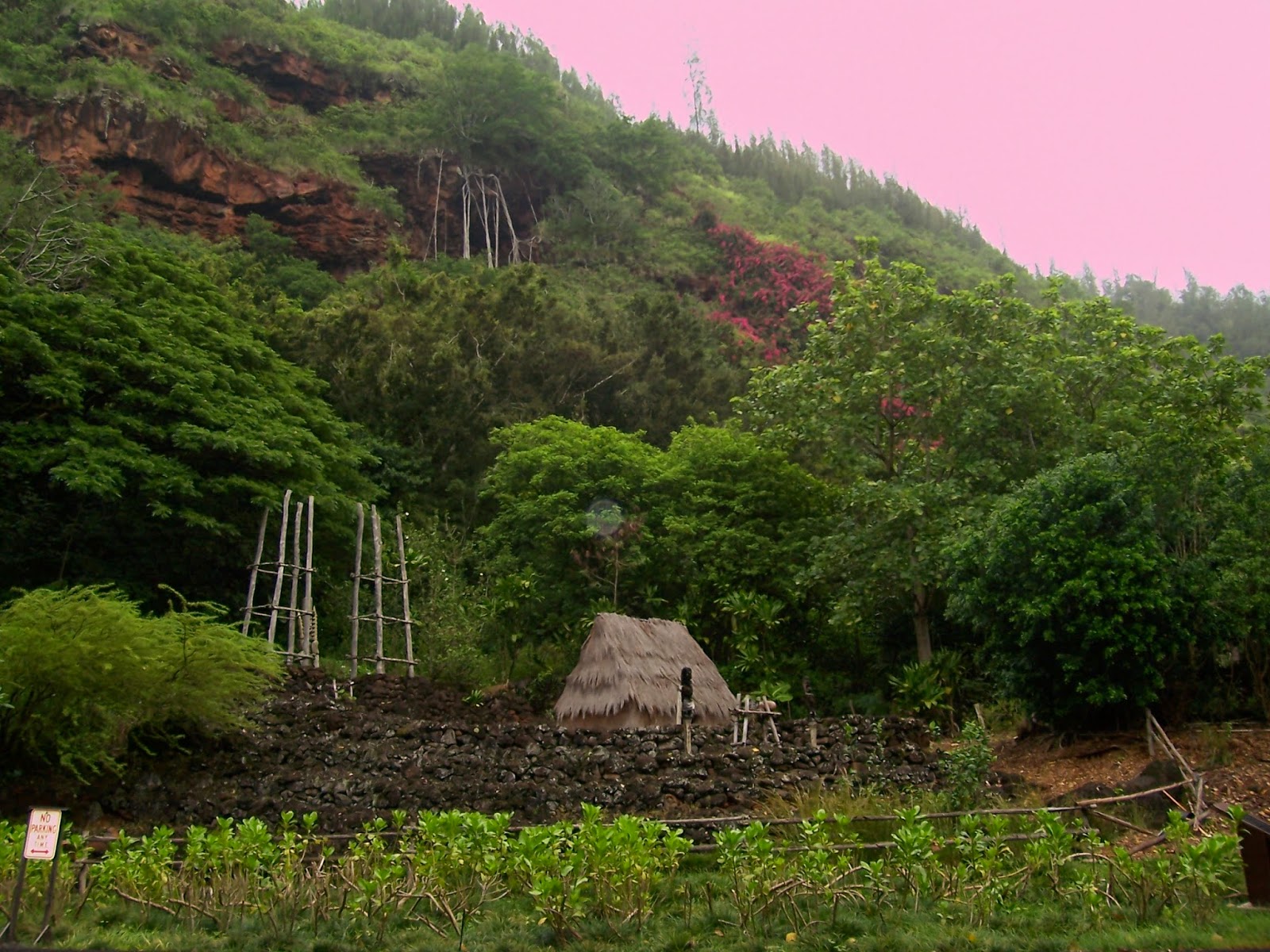It may not be ‘officially’ Makahiki season yet (I’m a couple
weeks early) but the Pleiades is coming up in the late night sky now—and will
soon be on the horizon at the time when the temple priests would be declaring
it time to put away the war god, Ku, and pay tribute to the harvest/ fertility
god, Lono. I use the term ‘tribute’ to not only include the rituals of honor,
but to also include the time to pay the yearly ‘taxes’ to the king—after the
harvest.
Waimea Valley on the North Shore of Oahu is known as the
valley of the priests. The last Lono priest to live here was Hewahewa, kahuna during the reign of
Kamehameha. After Ka’ahumanu took
over and he was not able to gain the trust of the missionaries (even though he
had converted to Christianity and was one of the leaders in the overthrow of
the kapus), Hewahewa retired to
Waimea where his ancestors had lived since the time of Pa’ao. Hale o Lono heiau is right outside the entrance to the botanical gardens.
The valley has been through a series of owners, and finally
OHA has complete possession, caretaking the botanical gardens and turning the
valley into a Hawaiian experience.
The grass houses are being rebuilt. I was particularly interested in the ladder—quite ingenious,
actually.
In the park are wondrous plantings from Hawaii and around
the world. At the end of a three quarter mile walk is the waterfall. Even though the water was still murky
from recent rains, the lifeguards are stationed at the pool below the
waterfall, ready to help people on with their life vests, which are now
required after there had been a couple of people who didn’t make it back to
shore. As the lifeguard helped me on with my swim vest, I kidded him about the mo’o grabbing people, but he pretended
not to hear me, just saying, “Be careful and stay away from the left
side…falling rocks, you know.” So I eased myself into the refreshing pool,
paddled across the pond to the waterfall, said my harvest prayers, and paddled
back.
The Picture I Did Not Take
After we had wandered the gardens for several hours, I asked my
friend Karen (a relative newcomer to the island) if she wanted to see the
sacrificial heiau, Pulu o Mahuka, on
the top of the ridge. We drove up the hill, then down the road and parked the
car. Karen went over to the plaques that explain the surroundings and was
reading the information. A plastic bag floating in the breeze captured my
attention. I was not the only one
looking at the floating plastic; it had also captivated the attention of a very
large black pig. I quickly surveyed our situation: there was a rock wall
between us and the pig, but pigs
(even a fat pig) can outrun a person. I used my rusty geometry calculations to
measure the angle of the pig to the car, and the distance from the people to the car…and realized
that if the pig got it in her mind that we were worthy of her attention, she could beat us to the car. “Eh…Karen…” I said, not
wanting to alarm her, “there is a pig over there. They can be dangerous. Let’s
very calmly move toward the car… just in case.” It was only when we started to
move that the pig noticed us—and came to the edge of the rock wall. When the
sow realized we were moving away from her—and not coming toward her, she
halted. As we watched from the safety of the car, she went back to her
pineapple.
People are asked to stay out of the temple, but
they leave offerings near the fence at the upper end of the heiau. I, myself, have been known to leave a flower, a coin, or a
piece of fruit by the hole in the barbed wire fence. Someone had wrapped a
dendrobia orchid lei around the
fencepost. On the ground the hog was wrestling with a large pineapple. She
picked it up by the green, prickly end—and dropped it when it poked her in the
eye. She picked it up again—and dropped it. Finally she pushed the pineapple
around with her snout, picked it up by the ‘meat’ end, and trotted off through
the hole in the fence to the jungle.
I laughed out loud. “People think the gods eat the fruit,” I chuckled.
“And really the pig gets it!” It
was only after I was driving away that I realized I should have pulled out the
camera and gotten a picture of the pig! It is only the third pig I’ve ever seen
in Hawaii—counting the boar I saw strapped to a pickup hood one Sunday
afternoon when the hunters and the barking dogs in the back announced their
kill to the neighborhood.
The next day, on my way over the pali, I saw two smaller--again black--porkers by the
side of the road. They were not big enough to have been living on their own, so
I surmised the momma must have not fit through the fence, but was watching from
the safety of the jungle nearby.
Two pig sightings in less than 24 hours?! How
could that be? I went to my library to research Hawaiian culture and learned more about
Lono, the god of the rainy season. In one of his physical manifestations he
presents as an all black pig, pua’a hiwa.
In his mythological human form, he is Kamapua’a, the pig god who was one of Madame Pele's lovers. And
so, I understood that my prayers of thanksgiving had been acknowledged.




No comments:
Post a Comment